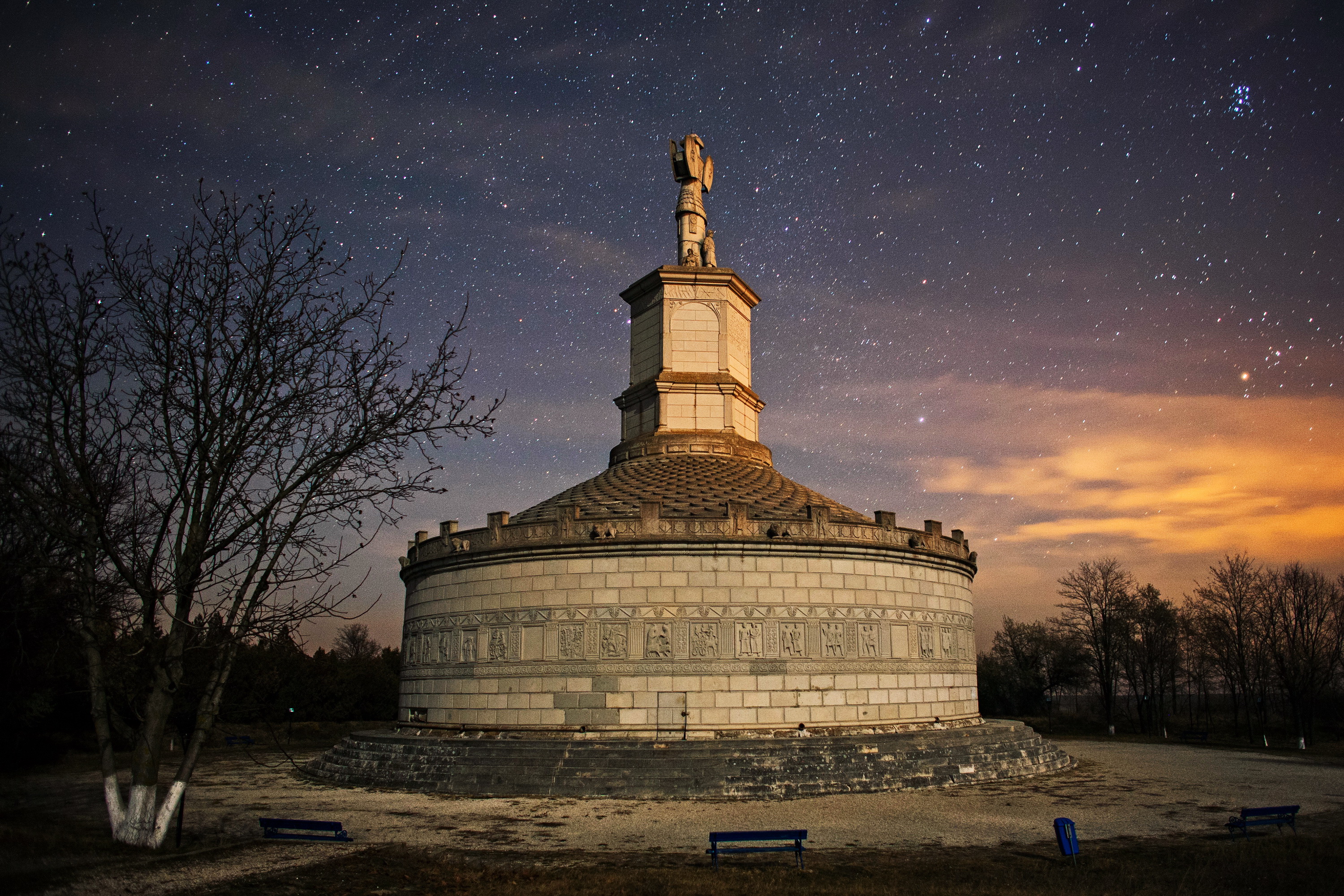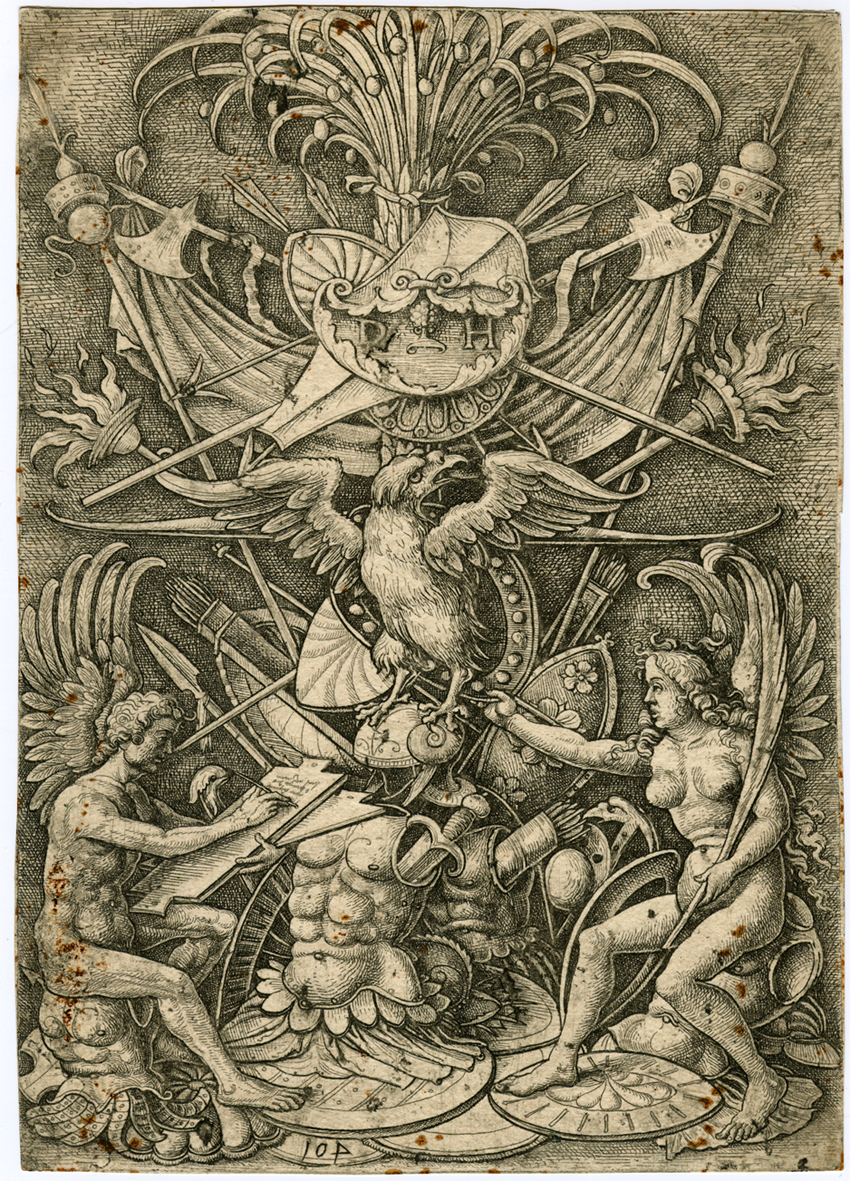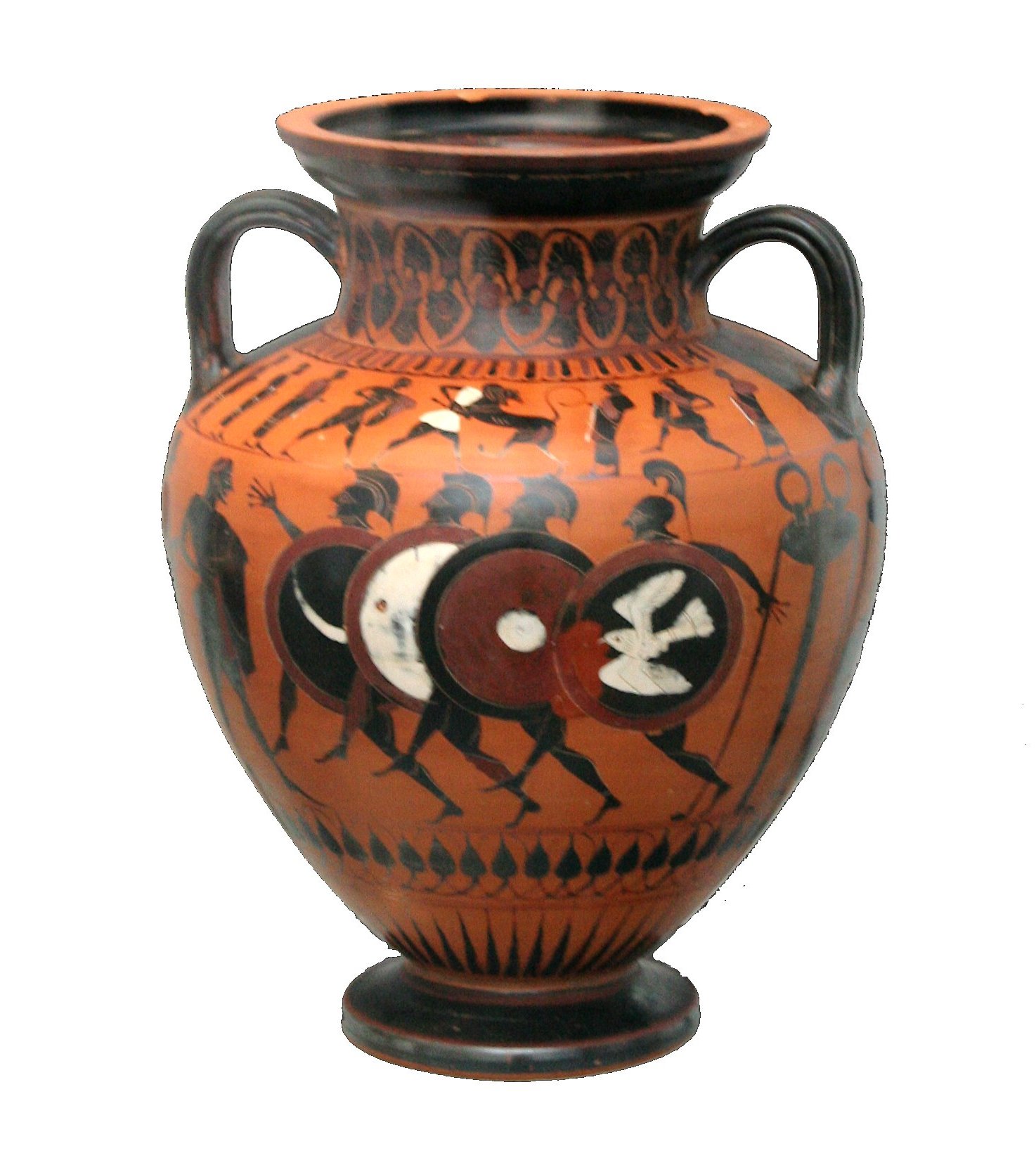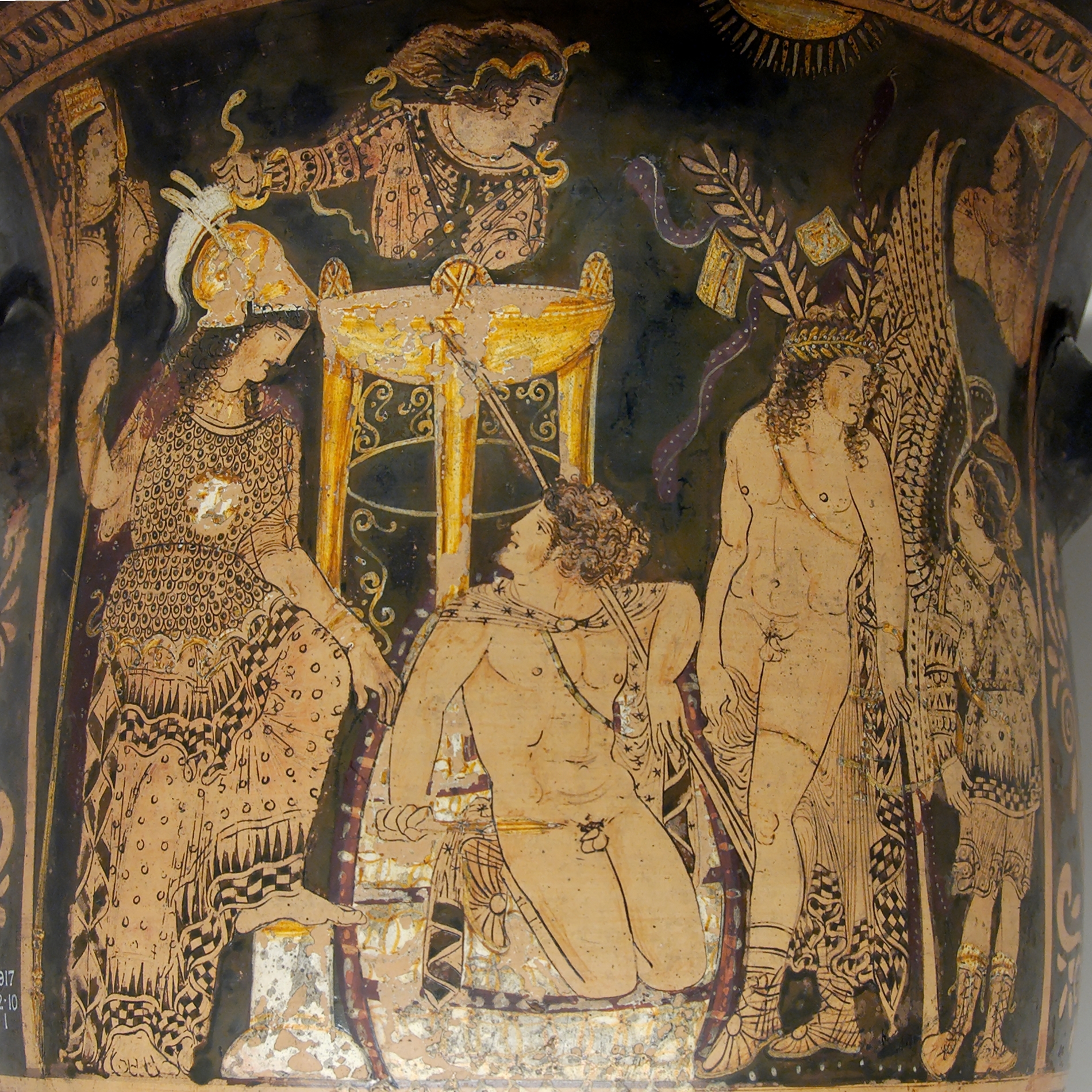|
Tropaion
A tropaion ( el, τρόπαιον, la, tropaeum), from which the English word, " trophy", is derived, was a monument erected to commemorate a victory over one's foes by the ancient Greeks and later, by the Romans. The armour of the defeated foe would be hung upon the monument. Originally, the location of the monument was the battlefield where the commemorated victory took place. Initially, the typical monument was constructed out of a living tree with lateral branches, or it was constructed in the shape of one. After construction, the ''tropaion'' was dedicated to a deity in thanksgiving for the victory. Some images of tropaion show many weapons and shields heaped below the armor hoisted upon the monument. In later times, pairs of lances, banners, or stakes set crosswise might be used instead of the tree format. Greece In the Greek city-states of the Archaic period, a ''tropaion'' would be set up on the battlefield itself, usually at the site of the "turning point" (Gk. ''trop ... [...More Info...] [...Related Items...] OR: [Wikipedia] [Google] [Baidu] |
Tropaeum Traiani
The Tropaeum Traiani or Trajanic Trophy is a monument in Roman Civitas Tropaensium (site of modern Adamclisi Adamclisi () is a commune in Constanța County, in the Dobrogea region of Romania. History In ancient times, a Roman castrum named Civitas Tropaensium was settled here and in 109 AD a monument named Tropaeum Traiani was built to commemorate the ..., Romania), built in AD 109 in then Moesia Inferior, to commemorate Roman Emperor Trajan's victory over the Dacians, in the winter of 101–102, in the Battle of Adamclisi. Before Trajan's construction, an altar existed there, on the walls of which were inscribed the names of the 3,000 legionaries and auxilia (servicemen) who had died "fighting for the Republic". (Latin: Tropaeum from Greek: Tropaion, source of English: "trophy"). Compared to Trajan's Column in Rome, erected to celebrate the same victories and a "product of Roman metropolitan art", the sculpted metopes have been described as in "barbarian provincial taste", ... [...More Info...] [...Related Items...] OR: [Wikipedia] [Google] [Baidu] |
Trophy (architectural)
A trophy or trophy of arms in art and architecture is a real or depicted artistically assembled display of weaponry and other militaria, often captured from a defeated enemy, as an ornament designed for the purpose of triumphalist display by a victor or as a show of military prowess by a monarch. Similar decorative vertical arrangements of hunting accessories, musical instruments or other objects are also commonly referred to as trophies. The term comes from the ancient Greek ''tropaion'' and Roman equivalent ''tropaeum'', military victories which were commemorated with a display of actual captured arms, armour and standards. The use of trophies as an ornament in decoration became popular in the Italian Renaissance, and as an architectural element in relief or free-standing sculpture during the Baroque era, where they are often used as a kind of finial to decorate rooflines, gate columns and other elements of buildings with military associations, which included most royal pala ... [...More Info...] [...Related Items...] OR: [Wikipedia] [Google] [Baidu] |
Trophy
A trophy is a tangible, durable reminder of a specific achievement, and serves as a recognition or evidence of merit. Trophies are often awarded for sporting events, from youth sports to professional level athletics. In many sports medals (or, in North America, rings) are often given out either as the trophy or along with more traditional trophies. Originally the word trophy, derived from the Greek ''tropaion'', referred to arms, standards, other property, or human captives and body parts (e.g., headhunting) captured in battle. These war trophies commemorated the military victories of a state, army or individual combatant. In modern warfare trophy taking is discouraged, but this sense of the word is reflected in hunting trophies and human trophy collecting by serial killers. Etymology Trophies have marked victories since ancient times. The word ''trophy'', coined in English in 1550, was derived from the French ''trophée'' in 1513, "a prize of war", from Old French ''trophee' ... [...More Info...] [...Related Items...] OR: [Wikipedia] [Google] [Baidu] |
Booty From The Dacian Wars
Booty may refer to: Music *Booty music (also known as Miami bass or booty bass), a subgenre of hip hop * "Booty" (Jennifer Lopez song), 2014 *Booty (Blac Youngsta song), 2017 * Booty (C. Tangana and Becky G song), 2018 *"Booty", a 1993 song by George Clinton from ''Paint the White House Black'' *"Booty", a 2000 song by Erykah Badu from ''Mama's Gun'' *"Booty", a 2007 song by Tito El Bambino from ''It's My Time'' (Tito El Bambino album) *''Booty'', a 2008 album by Die Türen *"Da Booty", a 1998 song by A Tribe Called Quest from ''The Love Movement'' *"Booty", a 2022 single by Latto and Saucy Santana that blew up online People *Frederick Booty (1841–1924), philatelist *John Booty (b. 1965), American football player *John David Booty (b. 1985), American football player *Josh Booty (b. 1975), baseball and American football player *Justin Booty (b. 1976), soccer player *Kasma Booty (1932–2007), Malaysian actor *Martyn Booty (born 1971), footballer *Ray Booty (1932–2012), Briti ... [...More Info...] [...Related Items...] OR: [Wikipedia] [Google] [Baidu] |
Aspis
An aspis ( grc, ἀσπίς, plural ''aspides'', ), or porpax shield, sometimes mistakenly referred to as a hoplon ( el, ὅπλον) (a term actually referring to the whole equipment of a hoplite), was the heavy wooden shield used by the infantry in various periods of ancient Greece. Construction An aspis was deeply dished and made primarily of wood. Some had a thin sheet of bronze on the outer face, often just around the rim. In some periods, the convention was to decorate the shield; in others, it was usually left plain. The aspis measured at least in diameter and weighed about , and it was about thick. This large shield was made possible partly by its shape, which allowed it to be supported comfortably on the shoulder. The revolutionary part of the shield was, in fact, the grip. Known as an grip, it placed the handle at the edge of the shield and was supported by a leather or bronze fastening for the forearm at the center, known as the porpax. This allowed hoplites m ... [...More Info...] [...Related Items...] OR: [Wikipedia] [Google] [Baidu] |
Musei Capitolini
The Capitoline Museums (Italian: ''Musei Capitolini'') are a group of art and archaeological museums in Piazza del Campidoglio, on top of the Capitoline Hill in Rome, Italy. The historic seats of the museums are Palazzo dei Conservatori and Palazzo Nuovo, facing on the central trapezoidal piazza in a plan conceived by Michelangelo in 1536 and executed over a period of more than 400 years. The history of the museum can be traced to 1471, when Pope Sixtus IV donated a collection of important ancient bronzes to the people of Rome and located them on the Capitoline Hill. Since then, the museums' collection has grown to include many ancient Roman statues, inscriptions, and other artifacts; a collection of medieval and Renaissance art; and collections of jewels, coins, and other items. The museums are owned and operated by the municipality of Rome. The statue of a mounted rider in the centre of the piazza is of Emperor Marcus Aurelius. It is a copy, the original being housed on-sit ... [...More Info...] [...Related Items...] OR: [Wikipedia] [Google] [Baidu] |
Roman Triumph
The Roman triumph (') was a civil religion, civil ceremony and Religion in ancient Rome, religious rite of ancient Rome, held to publicly celebrate and sanctify the success of a military commander who had led Roman forces to victory in the service of the state or in some historical traditions, one who had successfully completed a foreign war. On the day of his triumph, the general wore a crown of laurel and an all-purple, gold-embroidered triumphal ''toga picta'' ("painted" toga), regalia that identified him as near-divine or near-kingly. In some accounts, his face was painted red, perhaps in imitation of Rome's highest and most powerful god, Jupiter (mythology), Jupiter. The general rode in a four-horse chariot through the streets of Rome in unarmed procession with his army, captives, and the spoils of his war. At Temple of Jupiter Optimus Maximus, Jupiter's temple on the Capitoline Hill, he offered sacrifice and the tokens of his victory to the god Jupiter. In Roman Republic, ... [...More Info...] [...Related Items...] OR: [Wikipedia] [Google] [Baidu] |
Cursus Honorum
The ''cursus honorum'' (; , or more colloquially 'ladder of offices') was the sequential order of public offices held by aspiring politicians in the Roman Republic and the early Roman Empire. It was designed for men of senatorial rank. The ''cursus honorum'' comprised a mixture of military and political administration posts; the ultimate prize for winning election to each "rung" in the sequence was to become one of the two ''consuls'' in a given year. Each office had a minimum age for election; there were also minimum intervals between holding successive offices and laws forbade repeating an office. These rules were altered and flagrantly ignored in the course of the last century of the Republic. For example, Gaius Marius held consulships for five years in a row between 104 BC and 100 BC. He was consul seven times in all, also serving in 107 and 86. Officially presented as opportunities for public service, the offices often became mere opportunities for self-aggrandizement. ... [...More Info...] [...Related Items...] OR: [Wikipedia] [Google] [Baidu] |
Roman Republic
The Roman Republic ( la, Res publica Romana ) was a form of government of Rome and the era of the classical Roman civilization when it was run through public representation of the Roman people. Beginning with the overthrow of the Roman Kingdom (traditionally dated to 509 BC) and ending in 27 BC with the establishment of the Roman Empire, Rome's control rapidly expanded during this period—from the city's immediate surroundings to hegemony over the entire Mediterranean world. Roman society under the Republic was primarily a cultural mix of Latin and Etruscan societies, as well as of Sabine, Oscan, and Greek cultural elements, which is especially visible in the Roman Pantheon. Its political organization developed, at around the same time as direct democracy in Ancient Greece, with collective and annual magistracies, overseen by a senate. The top magistrates were the two consuls, who had an extensive range of executive, legislative, judicial, military, and religious powers ... [...More Info...] [...Related Items...] OR: [Wikipedia] [Google] [Baidu] |
Sparta
Sparta ( Doric Greek: Σπάρτα, ''Spártā''; Attic Greek: Σπάρτη, ''Spártē'') was a prominent city-state in Laconia, in ancient Greece. In antiquity, the city-state was known as Lacedaemon (, ), while the name Sparta referred to its main settlement on the banks of the Eurotas River in Laconia, in south-eastern Peloponnese. Around 650 BC, it rose to become the dominant military land-power in ancient Greece. Given its military pre-eminence, Sparta was recognized as the leading force of the unified Greek military during the Greco-Persian Wars, in rivalry with the rising naval power of Athens. Sparta was the principal enemy of Athens during the Peloponnesian War (431–404 BC), from which it emerged victorious after the Battle of Aegospotami. The decisive Battle of Leuctra in 371 BC ended the Spartan hegemony, although the city-state maintained its political independence until its forced integration into the Achaean League in 192 BC. The city nevertheless ... [...More Info...] [...Related Items...] OR: [Wikipedia] [Google] [Baidu] |
Orestes
In Greek mythology, Orestes or Orestis (; grc-gre, Ὀρέστης ) was the son of Clytemnestra and Agamemnon, and the brother of Electra. He is the subject of several Ancient Greek plays and of various myths connected with his madness and purification, which retain obscure threads of much older ones. Etymology The Greek name Ὀρέστης, having become "Orestēs" in Latin and its descendants, is derived from Greek ὄρος (óros, “mountain”) and ἵστημι (hístēmi, “to stand”), and so can be thought to have the meaning "stands on a mountain". Greek literature Homer In the Homeric telling of the story, Orestes is a member of the doomed house of Atreus, which is descended from Tantalus and Niobe. He is absent from Mycenae when his father, Agamemnon, returns from the Trojan War with the Trojan princess Cassandra as his concubine, and thus not present for Agamemnon's murder by Aegisthus, the lover of his wife, Clytemnestra. Seven years later, Orestes retu ... [...More Info...] [...Related Items...] OR: [Wikipedia] [Google] [Baidu] |
Herodotus
Herodotus ( ; grc, , }; BC) was an ancient Greek historian and geographer from the Greek city of Halicarnassus, part of the Persian Empire (now Bodrum, Turkey) and a later citizen of Thurii in modern Calabria ( Italy). He is known for having written the '' Histories'' – a detailed account of the Greco-Persian Wars. Herodotus was the first writer to perform systematic investigation of historical events. He is referred to as " The Father of History", a title conferred on him by the ancient Roman orator Cicero. The ''Histories'' primarily cover the lives of prominent kings and famous battles such as Marathon, Thermopylae, Artemisium, Salamis, Plataea, and Mycale. His work deviates from the main topics to provide a cultural, ethnographical, geographical, and historiographical background that forms an essential part of the narrative and provides readers with a wellspring of additional information. Herodotus has been criticized for his inclusion of "legends and f ... [...More Info...] [...Related Items...] OR: [Wikipedia] [Google] [Baidu] |
_lower.jpg)









